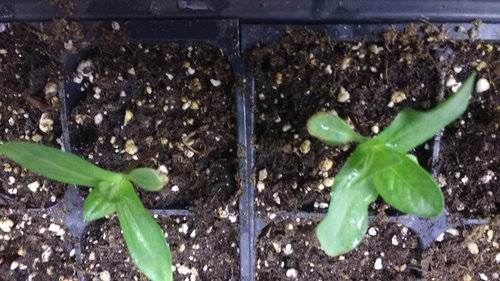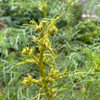Yo zen_man!
Howdy neighbor! Hope ya haven't lost your internet in the ice!
I'm thinking I've got a Benary's Giant issue cropping up. First let me say, I lost my entire crop of Magellans last spring with some form of fungus, I guess (never responded to Daconil) & this brings me to question if I'm having the same issue with these..... Notice the brown tips on the leaves....

Comments (24)
ken_adrian Adrian MI cold Z5
7 years agothis sounds so personal ... i hope you dont mind me interjecting ....
when i grew seeds indoors... hosta ... i learned that PREVENTION is much easier than CURING ...
so i started by washing EVERYTHING in a 10% bleach solution ... pots... trays .. tools.. watering bottles and cans.. etc ...
then i sterilized my media ... see link below ...
i did the sterilizing both ways ... using a dollar store turkey pan and alum foil [punch holes] for a giant batch in the oven ... or grocery bags in the microwave for smaller lots ...
moisten the media properly.. and when you see steam out of either ... close enough ...
got rid of bugs...[which are a nightmare in the house in winter... algae ... [though learning how to water helps that.. lol]... and disease ...
think of your setup as an operating room.. and clean it at the start ....
kenRelated Professionals
Derry Landscape Architects & Landscape Designers · Windham Landscape Architects & Landscape Designers · Williamsburg Landscape Contractors · Annandale Landscape Contractors · Del Aire Landscape Contractors · Hawthorne Landscape Contractors · Secaucus Landscape Contractors · Shaker Heights Landscape Contractors · Eustis Driveway Installation & Maintenance · Batavia Decks, Patios & Outdoor Enclosures · Billerica Decks, Patios & Outdoor Enclosures · Foothill Farms Decks, Patios & Outdoor Enclosures · Greeley Decks, Patios & Outdoor Enclosures · Harrisburg Decks, Patios & Outdoor Enclosures · Lincolnton Decks, Patios & Outdoor Enclosuresgltrap54
Original Author7 years agoThanks ZM for taking the time to respond! I greatly value your zinnia expertise! That said.....
First off, about the nutrient deficiency, these seedlings are 30 days old & I'm assuming they shouldn't need any fertilizer yet (when started in ProMix BX) ??
I'll be using a systemic fungicides on my flowers going forward. Never knew the difference... Do you have a brand preference?
I'll dig for some pics of my failed Magellans.... I must have started to send you some a dozen times & never remembered..... I was soooo bummed out :(
Wife recently joined me in retirement & we joined the Downtown Farmer's Market last season & hope to add cut flowers to our offerings this season. I've started a few things, just experimenting..... My gh is now operational year around (after a few upgrades recently), so I'm trying to utilize it...... Hope you're watching the Chiefs annihilate Pittsburgh from home tomorrow! Wouldn't be much fun driving to Arrowhead, although the atmosphere will intoxicating! GO CHIEFS!!!!!!!!!!
Trapper
zen_man
7 years agoHi Ken,
Your comments are always welcome. I do agree that prevention is better than cure. It is just that I am growing enough zinnias indoors to involve a non-negligible investment in systemic fungicide to protect them. So I wait until I see that first hint of fungus before invoking my prevention program. I am not curing an outbreak, I am preventing it. Here it is the middle of January, and I still haven't had to use any systemic fungicide. Some years I get through the entire indoors operation without needing to use systemic fungicide. There is a kind of "if its not broke, don't fix it" aspect to that plan.
And my indoors zinnia growing program does fall rather far short of a hospital operating room. There is never a nurse there to hand me a trowel when I need it.
ZM
zen_man
7 years agolast modified: 7 years agoHi trapper,
" Do you have a brand preference? "
My favorite systemic fungicide active ingredient is Tebuconazole. I use the product called Bayer Advanced Disease Control for Roses, Flowers & Shrubs.
" First off, about the nutrient deficiency, these seedlings are 30 days old & I'm assuming they shouldn't need any fertilizer yet (when started in ProMix BX) ?? "
You should read the label on your ProMix BX. It has essentially NO nutrients. The Pro-Mix BX ingredients are:
Canadian Sphagnum Peat Moss 75-85%
Perlite - horticultural grade
Vermiculite - horticultural grade
Dolomitic and Calcitic limestone (pH adjuster)
Wetting Agent
The Pro-Mix BX label says "Begin fertilization within 7 days after planting"
Notice that the limestone is there only to adjust pH, and NOT to supply nutrient amounts of either Calcium or Magnesium. So you will need to add Calcium nitrate soon to avoid Calcium deficiency symptoms, unless your water supply is loaded with Calcium. Get an analysis sheet for your water if it is available. Some municipal water companies will supply that. And you will also need to add a complete nutrient formula after 7 days to avoid nutrient deficiencies of ALL sorts. The water that you using may be hard, and contain a small amount of Calcium and/or Magnesium, but I think it is safe to say that you have nutrient deficiencies of pretty much ALL nutrient elements.
Incidentally, I have switched to Premier Pro-Mix HP (high porosity) for its much higher Perlite content. I had been adding Perlite to my BX, and now I don't have to do that. I still have an unopened bale of BX (and some Miracle-Gro Perlite) for a "rainy day".
" I'll dig for some pics of my failed Magellans.... I must have started to send you some a dozen times & never remembered..... I was soooo bummed out :( "
You had every right to be bummed -- zinnias are supposed to be dependable. Now that your greenhouse is operational and you have plans to sell cut flowers, we need to work out all the "kinks" in your zinnia operation.
ZM (not associated with any product or vendor mentioned or linked)
gltrap54
Original Author7 years ago
I see Bayer Advanced Disease Control for Roses, Flowers & Shrubs on the shelf at our local Wally World, so I'll be sure to invest in some......Wow! No wonder my Benary's Giants are doing so poorly! Label me as clueless on the nutrient issue (& so many others LOL)........ Guess I should have started by reading the ProMix label,ha ha..... Topeka's city water is about 4-500 ppm from the tap........ At this point what should I use for fertilizer & how many ppm?
And yes, I'll switch from BX to to HP......
Don't give up on me ZM, I'm going to produce those cut flowers still yet! :)
Trapperzen_man
7 years agoHi Trapper,
" Wow! No wonder my Benary's Giants are doing so poorly! "
Actually they are doing worse than just a few brown tips. I and other zinnia growers typically get zinnias in bloom only 5 weeks after planting indoors. The books say 6 weeks and some go as long as 8 weeks, but that reflects different climates. But 5 weeks is 35 days, so your zinnia plants should be two to three times their current size, and only 5 days away from being in bloom. Living on zero food has taken its toll, and it actually is kind of remarkable that they are still clinging onto life.
" Topeka's city water is about 4-500 ppm from the tap "
Try to get an analysis sheet of the Topeka water. One should be available at the Water Department, since Topeka is a major city. The more you know about the water you are applying to your plants, the better. What does it contain in the way of trace elements? By any chance, does it contain any Silicon? And is it fluoridated?
" At this point what should I use for fertilizer & how many ppm? "
Since Pro-Mix is sterile, it contains no soil microbes to convert Urea into usable ammonium and nitrate ions, so you probably should use a urea-free soluble nutrient product. I said "probably" simply because I don't know for certain that zinnias can't take in and use urea through their roots. One participant in this forum (see the It can be fun to breed your own zinnias - Part 39: message thread), Jai (Jack) Ganesha has used Miracle-Gro Bloom Booster successfully in growing zinnias indoors, and it contains urea. I don't know whether Jack's pots contain soil microbes or not. Zinnias can absorb urea through their leaves in foliar feeding. So it is an open question whether the Miracle-Gro nutrients would be suitable for zinnias in your greenhouse. I use a lot of Miracle-Gro Tomato Food on my outdoors zinnias. It contains more Magnesium than the other Miracle-Gro nutrient formulas. Zinnias may be able to absorb urea through their roots, but possibly not. It would be interesting to know the answer to that question.
However, to be on the "safe" side, I will tell you what I have been using indoors in Pro-Mix. I use Better-Gro Orchid Plus and Better-Gro Better Bloom. For more information, see the Better-Gro Orchid Food website. Those two products are probably in stock in Loews in Topeka. (That's where I get mine) A full strength application would be one Tablespoon per gallon. Since I make multiple applications, I use weaker one teaspoon per gallon doses in my plant water. I also add some Calcium nitrate and a skosh extra Boron as boric acid, because zinnias seem to like a bit more Boron than "average" plants. Be careful with the boric acid, it doesn't take much Boron to be phytotoxic. There may even be some Boron in your Topeka water. Some irrigation water in California contains dangerous amounts of Boron.
Incidentally, do you get your Pro-Mix from Hummert International on Moundview Drive in Topeka? That is where I get my Pro-Mix, and they seem to have a good selection.
" Don't give up on me ZM, I'm going to produce those cut flowers still yet! :) "
I have no doubt that you will.
ZM (not associated with any product or vendor mentioned or linked)
ken_adrian Adrian MI cold Z5
7 years agoI do agree that prevention is better than cure. ...... So I wait until I see that first
hint of fungus before invoking my prevention program.
==>>> i have no qualms about going nuclear.. when there is a problem to solve ... two thumbs up on your method ...
im going to leave you two to it ... have you discussed what his light setup is.. and how close they are... etc .... improper lighting is a source of lack of self produced nutrition ....
keep up Gods work ... kengltrap54
Original Author7 years agoWell shoot...... Just a bit (no, a lot) red faced here..... I've been propagating from seed for 5+ years, I should know better... Should I start over with fresh seed or attempt to work with these? I started one (32) flat & wound up with 25 seedlings......
I think I can download an analysis sheet from the water dept. website & I'll post the trace elements..........
As for fertilizer (yes, I DO use fertilizer, ha ha ) I use Miracle Gro All Purpose Plant Food (24/8/16) at half strength to start ..... Since Lowe's carries the Better-Gro Orchid Plus and Better-Gro Better Bloom, I'll give them a try as well.....
Yes, I do buy my Pro-Mix from Hummert International..... I'm less than ten minutes from them... When I began my "propagation journey", I learned some of the basics from dear ol' digdirt Dave over on the vegetable gardening forum. He got me started on ProMix......
zen_man
7 years agoHi Trapper,
" Should I start over with fresh seed or attempt to work with these? "
Why not do both? If you plan to sell cut flowers at the Farmer's Market, you will probably want to have a successive supply of zinnias. A successive supply suggests successive planting. Do you have your current zinnia seedlings in your greenhouse, or under lights inside, or what? How large is your greenhouse? You might want to bring zinnia blooms to the Farmer's Market over a period of weeks, or possibly even months, if the zinnias sell reasonably well.
The most efficient way to produce zinnias is to plant them in rows in-ground after the soil warms up a bit in the Spring. I plant outdoors from mid April to mid July. That gives me a three-month span of successive zinnia planting (half a month in April and half a month in July). It is actually convenient not to have them all start blooming at the same time.
Do you plan to grow a bunch of zinnias outdoors in-ground? If so, how much space outdoors do you have available? Most zinnia cut-flower producers do all of their production outside in-ground. They grow zinnias like a row crop. Johnny's Selected Seeds is one seed company that caters to both home gardeners and market gardeners alike. Hazzards Seeds caters to commercial growers, but will sell to the home grower who doesn't mind buying larger packets of seeds.
Market gardeners who grow zinnias in quantity frequently use two-wheeled seeders to make it easy to plant rows of zinnias in a reasonably short time. Sometimes they use pelleted zinnia seed, which makes it easier for the mechanical seeder to place the seeds one-at-a-time. If your initial entry into selling zinnia cut flowers is successful, you might want to expand your operation in future years. A couple of years ago I actually lusted after a mechanical seeder to plant a lot of zinnias fast, but realized that my experimental hybrids wouldn't be uniform enough to make that practical.
I do use a funnel-tube seeder to make it easy to plant zinnias in a row while seated on a tractor scoot. I do as much of my gardening as possible from a comfortable seated position.
ZM
gltrap54
Original Author7 years agoJust moved these seedlings from my heated shop (under lights) to my insulated, heated gh (6' x 8' El Cheapo Harbor Freight) & will start more seeds in the shop germination chamber shortly..... Don't actually have a market for my flowers/vegetables until the first week of April (Farmers Market runs mid April - mid November), but I'm just trying to iron out the kinks (ie, fertilization, ha ha) currently.... Successive planting will be implemented later.......
While I do have room for in ground planting (ie, two garden plots), I'm not sure how I'll approach this aspect..... I do a good deal of container/raised bed growing also...... I typically use Johnny's Selected Seeds for my vegetable seeds, but use Harris Seed for my annual flower seed.
Last season was my first at the DTFM & that was at my wife's urging since she had retired & is available to lend a hand... Years prior, I gave away any excess vegetables/flowers/eggs that we couldn't use or can. DTFM helps to defray some of the overhead I have (reads expensive hobby ). Although I own a mechanical planter, it collects dust, while I plant by hand. How do you spell back ache?
zen_man
7 years agoHi Trapper,
Keep us posted on your progress with the indoor/greenhouse activity. I'll have a go at any questions you might have, and your comments and photos are always welcome. Maybe the Chiefs will do better next season.
ZM
gltrap54
Original Author7 years agoHere's the most recent data on Topeka's water quality......... does anything raise a concern for a grower?
City of Topeka 2015 Water Quality Data
The City of Topeka Water Utility provides service for nearly 155,000 people in the Topeka, Shawnee County, and surrounding areas. The raw water source is supplied by the Kansas River and is processed at the Topeka Water Treatment Facility located at I-70 and MacVicar.
The Kansas River has its beginning near Junction City and its tributary rivers include the Republican, Smoky Hill, Blue, Solomon, and Saline Rivers. The reservoirs in the Kansas River Basin that provide additional reserves for Topeka include Kanopolis, Waconda, Milford, Tuttle Creek and Wilson.
The tables below list the results of the many analyses performed in 2015 on your water. The first column of numbers labeled "MCL" lists the maximum regulated level of contaminants that the United States Environmental Protection Agency and Kansas Department of Health and Environment have determined to be safe in your drinking water. The column labeled "Topeka Water" lists the 2015 summary of analyses results. Data for certain contaminants are more than one year old because regulations allow monitoring less than once per year because concentrations of these contaminants are not expected to vary significantly from year to year. As you will note from the following table, the water quality analyses results for the City of Topeka Water Utility fell below the Maximum Contaminant Level for every regulated chemical, microbial, and radionuclide contaminant.
Organic Contaminants There are a number of organic contaminants that are of concern in drinking water. This group includes: volatile organic contaminants that vaporize easily and are called VOC's; pesticides and herbicides that run off soils and contaminate river and reservoir water supplies; synthetic organic contaminants used in personal and manufacturing pursuits, and contaminants that occur as a by-product of water disinfection.
Contaminant
MCL (mg/L)
Topeka Water (mg/L)
Alachlor 0.002 N.D. Atrazine* 0.003 0.00057 Carbofuran 0.04 N.D. Chlordane 0.002 N.D. Endrin 0.002 N.D. Heptachlor 0.0004 N.D. Heptachlor Epoxide 0.0002 N.D. Hexachlorobenzene 0.001 N.D. Lindane 0.0002 N.D. Methoxychlor 0.04 N.D. Simazine 0.004 N.D. Toxaphene 0.003 N.D. Benzene 0.005 N.D. Carbon Tetrachloride 0.005 N.D.
Page 2 of 6
Chlorobenzene 0.1 N.D. p-Dichlorobenzene 0.075 N.D. o-Dichlorobenzene 0.6 N.D. 1,2-Dichloroethane 0.005 N.D. 1,1-Dichloroethylene 0.007 N.D. cis-1,2-Dichloroethylene 0.07 N.D. trans-1,2-Dichloroethylene 0.1 N.D. Dichloromethane 0.005 N.D. 1,2-Dichloropropane 0.005 N.D. Polychlorinated Biphenyls 0.0005 N.D. Ethylbenzene 0.7 N.D. Styrene 0.1 N.D. Trihalomethanes* 0.080 0.0510 Tetrachloroethylene 0.005 N.D. Toluene 1 N.D. 1,2,4-Trichlorobenzene 0.07 N.D. 1,1,1-Trichloroethane 0.2 N.D. 1,1,2-Trichloroethane 0.005 N.D. Trichloroethylene 0.005 N.D. Vinyl Chloride 0.002 N.D. Xylene 10 N.D. Ethylene Dibromide (EDB) 0.00005 N.D. Hexachlorocyclopentadiene 0.05 N.D. Haloacetic Acids (HAA5)* 0.06 0.0590 Chloramine* 4.0 3.27
N.D. = Not Detected.
* = Annual Average.
Page 3 of 6
Unregulated Organic Contaminant Monitoring (Not Associated with UCMR Regulation)
Contaminant
Topeka Water (mg/L) Acetochlor 0.00088 Aldrin N.D. Butachlor N.D. Dieldrin N.D. Deethylatrazine N.D. Met ibuzin 0.00020 Metolachlor 0.0055 Propachlor N.D. m,p-Xylene N.D. o-Xylene N.D. p,p’-DDT N.D. Alpha-BHC N.D. Treflan N.D. Pramitol N.D. p,p’-DDE N.D. p,p’-DDD N.D. Endosulfan Sulfate N.D. Endrin Aldehyde N.D. Endosulfan II N.D. Endosulfan I N.D. Dursban N.D. Diazinon N.D. Delta-BHC N.D. Deisopropyl Atrazine 0.00079 Dacthal N.D. Cyanazine (Bladex) N.D. Butylate N.D. Bromacil N.D. Beta-BHC N.D. Propazine (Milogard) N.D. Alachlor N.D.
Page 4 of 6
Inorganic Contaminants The Environmental Protection Agency sets standards for a number of inorganic contaminants that can affect health. Most regulated inorganic contaminants are metals, but some are chemical compounds and one is made of fibrous minerals.
Contaminant
MCL (mg/L)
Topeka Water (mg/L)
Antimony 0.006 N.D. Asbestos 7 MFL* N.D. Arsenic 0.010 N.D. Barium 2 0.046 Beryllium 0.004 N.D. Cadmium 0.005 N.D. Chromium 0.1 N.D. Fluoride 4 0.68 Mercury 0.002 N.D. Nickel 0.1 N.D. Nitrate 10 0.27 Selenium 0.05 0.0014 Thallium 0.002 N.D. Copper 1.3 AL** 0.028 Lead 0.015 AL** 0.0013
N.D. = Not Detected.
* = MFL - Millions of Fibers Per Liter > 10 Microns.
** = AL - Action Level. Copper and lead results are based on analyses of high risk homes. 90% of those homes are required to have copper and lead levels below Action Level.
Page 5 of 6
Microbiological Quality Bacteria and other harmful organisms are removed by disinfection and particle removal processes. The efficiency of these treatment techniques is monitored continuously to ensure the absence of these organisms and the clarity of the water.
Contaminant MCL
Topeka Water
Viruses: (Lowest Calc. CT Value) TT > 1.0* 2.6 Giardia lamblia: (Lowest Calc. CT Value) TT > 1.0* 1.4 Total Chlorine: (mg/L) > 1.0** 3.27 Total Coliforms: (Highest Monthly %) less than 5.0% 0.0% Fecal Coliforms: (Highest Monthly %) less than 0.0% 0.0% Turbidity: (Lowest Monthly %) less than 0.30 NTU*** 96.4% Total Organic Carbon: (TOC) TT > 1.0**** 1.85
* = TT - Treatment Technique. Monitoring and treatment requirements are measured in CT values.
** = > 1.0 Treatment Plant Effluent.
*** = NTU - Turbidity Units. 95% of monthly samples must be below MCL.
**** = TT - Treatment Technique. Average Removal Ratio calculated between actual and removal requirements.
Radiological Quality Radiological quality standards are set for specific contaminants and for the total radioactive element content.
Contaminant MCL* Topeka Water* Gross Alpha 15 pCi/L Less than 3 pCi/L Ra-226 5 pCi/L** Less than 1.0 pCi/L Ra-228 5 pCi/L** Less than 1.0 pCi/L Combined Radium 5 pCi/L Less than 1.0 pCi/L
* = Values in picoCuries/Liter.
** = Combined MCL for Ra-226 and Ra-228 is 5 pCi/L.
Page 6 of 6
General Water Quality Parameters There are many general, unregulated water quality parameters such as water hardness, iron and temperature that affect households and industries. Below is a listing of 2015 averages and historical, multi-year approximate normal ranges of many of those general water quality parameters.
Parameter Topeka Average Normal Range
pH 9.3 9.0 - 9.8 Chlorides (mg/L) 53 25 - 200 Sulfates (mg/L) 89 40 - 180 Total Hardness (mg/L as CaCO3) 162 110 - 230 Total Hardness (grains per gallon) 10 5 - 14 Calcium Hardness (mg/L as CaCO3) 141 100 - 170 Magnesium (mg/L) 5.5 8 - 26 Partial Alkalinity (mg/L as CaCO3 ) 23 10 - 35 Total Alkalinity (mg/L as CaCO3 ) 97 60 - 120 Total Dissolved Solids (mg/L) 310 200 - 600 Aluminum (mg/L) 0.025 0.0 - 0.2 Iron (mg/L) <0.010 0.0 - 0.2 Manganese (mg/L) <0.0010 0.0 - 0.01 Total Phosphorus (mg/L as P) 0.33 0.10 - 0.90 Potassium (mg/L) 7.5 6 - 12 Sodium (mg/L) 40 20 - 160 Temperature (° F) 65 33 - 80 Silica (mg/L) 7.8 5 - 10
Specific Conductance (umhos/cm) 624 450 - 900zen_man
7 years agoHi Trapper,
" Here's the most recent data on Topeka's water quality......... does anything raise a concern for a grower? "
For an indoor grower, yes. That data shows that the Topeka water is alkaline and has significant hardness, so, yes, prolonged use indoors could cause a buildup of salts that would become harmful to plants.
And after you add some soluble nutrients to the alkaline Topeka water, you should check the pH of the result to see if it is about 6.5 (slightly acid). If not, you should add something to lower the pH to the target range. (Don't add vinegar -- acetic acid is an effective herbicide.)
Our farm well water here also has even worse problems with hardness and pH and runoff contamination. So I run it through a Reverse Osmosis unit to produce water that is very close to distilled water or rain water for use on my plants. Unfortunately the RO water tastes just as "flat" as distilled water, so we drink Walmart drinking water that comes in one gallon plastic jugs. It has added minerals for flavor.
There is an easier-to-read version of the Topeka water analysis at this link,
2016 City of Topeka Water Quality Report
ZM
gltrap54
Original Author7 years agoThanks ZM! Still yet another arena where I fall short........... the internet...... ha,ha Need to check out this RO thing...... I'll check my pH..... I have a meter somewhere.....
zen_man
7 years agoHi Trapper,
They also have pH paper, which is reliable, reasonably accurate, and inexpensive. The pH meters can get out of calibration -- otherwise they are the most convenient to use.
" Need to check out this RO thing "
I got an under-the-counter Reverse Osmosis unit from The Perfect Water
I actually purchased it from among the Reverse Osmosis units at Amazon
There is a wide variety of units to pick from. When we first rented this farmhouse, we inspected the well and looked down there and you could see a bloated possum floating in the water. It was an old fashioned kind of well, consisting of a hole about 6 feet in diameter, maybe a little more. We had them put a secure wooden cover over the hole, because a child could fall in there and drown.And obviously the water was not pure, with a drowned rotting possum floating in it. So we referred to our tap water as "possum juice" and set the hot water tank temperature to near its maximum, so the hot water was near scalding. That much heat would at least kill any thing that was living in the hot water that we were washing our dishes and clothes with. We knew the well water was very hard, and my first indoor plant project ended in a heavy fatal salt accumulation in the pots after 5 or 6 weeks.
We had the same problem with the well water killing our plants when we lived in Maine, only it had a modern pipe-in-the ground configuration, so creatures drowning in the water was not an issue. But its salts would accumulate and kill plants. However, in Maine we had an endless supply of snow, so I simply melted snow in big plastic tubs and the melted snow was nearly like distilled water and worked fine all Winter for our plants.
But here in Kansas we didn't have a dependable supply of snow, so I settled on a Reverse Osmosis unit. I considered an electrical water home distillation unit, but the cost of our electricity was going to make the price per gallon of home distilled water too high. Our Reverse Osmosis unit works on our water pressure. It does use a small amount of electricity in its ultraviolet sterilization cell, but it costs a negligible amount to sterilize a gallon with intense UV. Since we are drinking and cooking with Walmart bottled water, we didn't need the re-mineralization feature that is an available option. The unit we wound up getting was the Home Master TMULTRA Ultra Undersink Reverse Osmosis Water Filter System
We are pleased with the system. The RO water is very close to distilled water, or the equivalent of very clean rain water. The plants love it. However, if your plants are doing OK with your Topeka water, save yourself the expense and hassle of installing a Reverse Osmosis unit. As they say, if its not broke, don't fix it.
ZM (not associated with any product or vendor mentioned or linked)
gltrap54
Original Author7 years agoWow ZM, you've had to be very resourceful in your search for potable water! Sounds like you've got it figured out. I've done a bit of research (mainly price) on Amazon for RO systems, but haven't pulled the trigger...Thanks for the links!
Your well episode reminded me of my years growing up as the youngest of 9 with an absent father & all we had was an old dilapidated cistern that we hauled water for..... Only by the grace of God were we not poisoned!
zen_man
7 years agoHi Trapper,
" Your well episode reminded me of my years growing up as the youngest of 9
with an absent father & all we had was an old dilapidated cistern
that we hauled water for..... Only by the grace of God were we not
poisoned! "It's possible that the cistern water actually exposed you to low levels of infectious germs that had the effect of "vaccinating" you against them.
" I've done a bit of research (mainly price) on Amazon for RO systems, but haven't pulled the trigger. "
You may not need an RO system. They cost money up front, can be a hassle to install, and you have a yearly expense of replacing the filter cartridges. Like I said, "if its not broke, don't fix it." I have been making heavy demands on my RO system this Winter, and probably should order a replacement set of filter cartridges, just to have them on hand in case the ones I have quit producing.
This is an example of a couple of my indoor zinnias a few days ago, just before I finally re-potted them to 5-inch square black plastic pots. I have some 8-inch square black plastic pots for when the 5-inch pots aren't big enough.
Those 3¼-inch orchid pots were woefully too small for those zinnias. You can see the roots through the "clear" pots. Those little pots don't hold a lot of Pro-Mix.
ZM
gltrap54
Original Author7 years agoI'm reluctant to ask :)........ Were these zinnias started from seed? If so, how old are they?
OBTW...... What is your fertilizing amount/ frequency for seedlings?
zen_man
7 years agoHi Trapper,
Both of them were planted on the 14th of December from seeds saved in my garden last year, and were repotted on 23rd of January, when the last picture was taken. So they were somewhere between 5 and 6 weeks old. If the conditions are good, a zinnia can start to bloom 5 weeks from inserting the seed into the growing medium.
" What is your fertilizing amount/ frequency for seedlings? "
It is a bit complicated. I start with a stock nutrient solution containing 1 teaspoon of Better-Gro Orchid Plus and 1 teaspoon of Better-Gro Orchid Better-Bloom per gallon. I have a separate stock solution of 1 tablespoon Calcium nitrate per gallon, and I add a half cup of that to each gallon of the Better-Gro nutrients. Along about the third or fourth week I replace the teaspoon of Orchid Plus with another teaspoon of Orchid Better-Bloom.
Sometimes I include a trace of Potassium silicate and a trace of Boric acid by adding small amounts of their stock solutions. The Boric acid stock solution contains 1/4 teaspoon of Boric acid powder per gallon. The Potassium silicate stock solution contains 8 teaspoons of ProTeKt per gallon. I might add a quarter cup of the Boric acid stock solution and maybe a tablespoon of the Potassium silicate stock solution per gallon of nutrient solution. I occasionally add a trace of Magnesium sulfate as an Epsom Salts stock solution (1 tsp/gal). However, the Better-Gro products contain some Magnesium, as does your Topeka water.
I apply the nutrient solution to the trays that the pots are in every week or two, maybe a quarter to half an inch deep. The plants sop it up quickly by capillary action of the growing medium. I apply some RO water to the trays every two or three days. Applying too much nutrients can be more harmful than not enough. I water the trays instead of the pots because watering the pots individually can be very tedious and time-consuming.
ZM (not associated with any product or vendor mentioned or linked)
gltrap54
Original Author7 years agoNow I'm green with envy.......
I've acquired both the Better-Gro Orchid Plus & the Better-Gro Orchid Better-Bloom from Lowes & have been using the Better-Gro Orchid Plus at 1/2 strength a couple times/week........ I wanted to get a better idea of your fertilization program, because I was pretty sure you weren't following the exact directions on each bag........
OK....... so now I need to get some idea of your light set up....... :)
zen_man
7 years agoHi Trapper,
" ...so now I need to get some idea of your light set up... "
I'll elaborate tomorrow, but the short answer is that I am using compact form factor T8 2-bulb shoplights, 4 per shelf, so that puts 8 bulbs over a 2' x 4' shelf. And I overdrive them for double the light output. The zinnias love all that light, and while I am working down there, so do I.
ZM
gltrap54
Original Author7 years ago
You had me there......Had to Google ODNO ...... :) I use 4' 4 bulb (T8, 6500K Daylight) fixtures/18" shelves........ Would appear you've got me out gunned for lighting... Just searching for anything that might improve seedling/transplant performance.....Trapper
zen_man
7 years agolast modified: 7 years agoHi Trapper,
I was introduced to overdriving fluorescent T8s here in GardenWeb long before Houzz acquired GardenWeb. The original I have found the BEST cheap fluorescent ballast/fixture message thread has been lost somehow, but its continuation, or part of it, has remained here. I lived in Maine at that time, so my name was maineman in that thread. (Actually, I was MaineMan, but Houzz "lowercased" me.) I learned to overdrive fluorescent fixtures from Zink in those message threads. My lighting is much improved because of that.
Of the basic RGB "visible" light mix, plants use the Red and the Blue and don't use the Green, so they reflect it and plants appear green for that reason. The 6500K bulb is an excellent source of Blue. You might want to to include a bulb somewhere in the 3000K range, to add a better source of Red.
ZM (aka maineman)


















zen_man